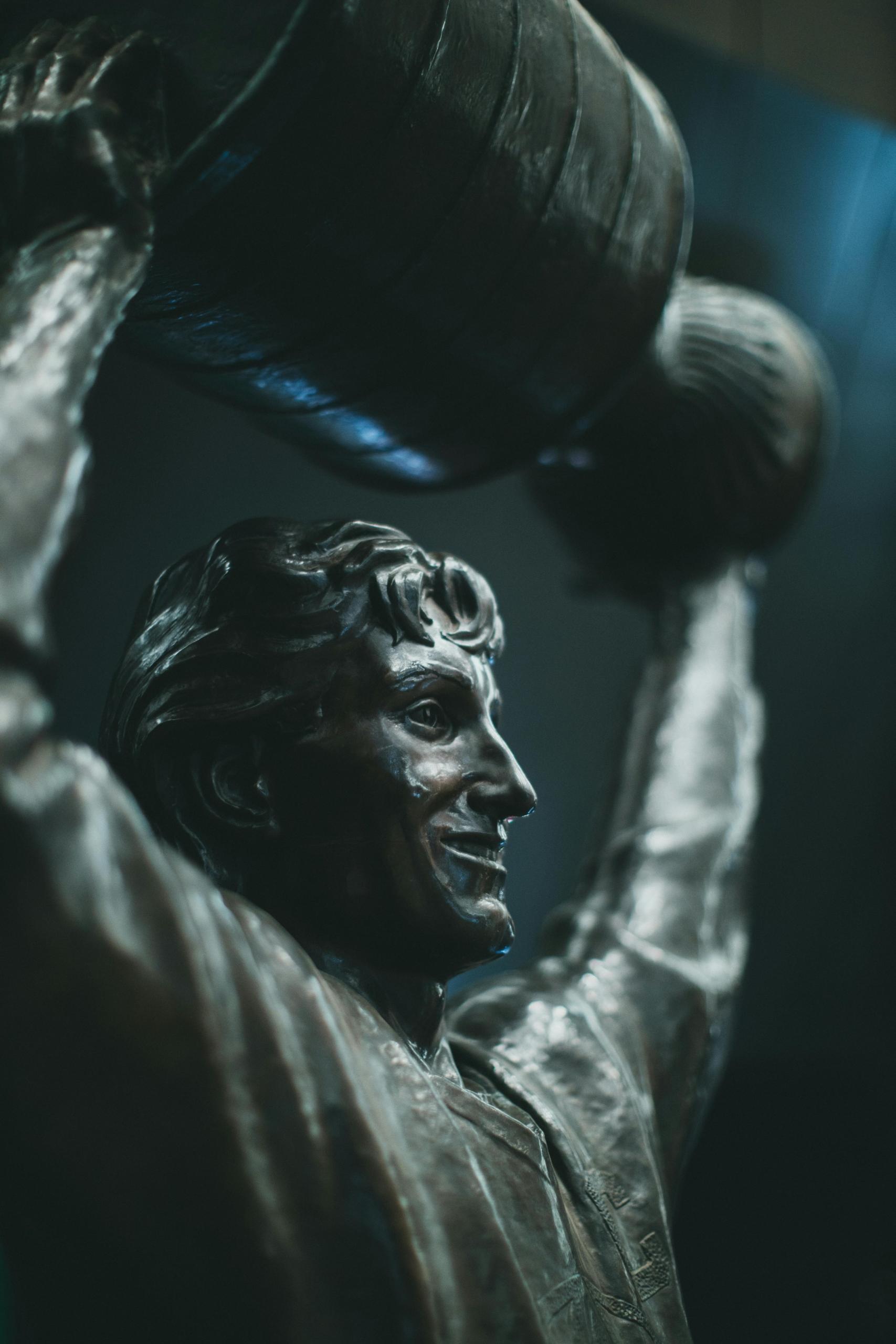Hockey is a sport that has become synonymous with Canada's image. What could be more quintessentially "Canadian" than a game of hockey on a local rink, or a night spent watching an NHL game with your friends and family at home or a stadium?
More than just a sport for millions of Canadians, hockey is a cultural institution and a core part of the national identity. But why does hockey claim such a special part of the Canadian imagination? Where did the sport get its start?
This article is all about the history of ice hockey in Canada, from a simple ball and stick game brought over by Scottish, British, and Irish immigrants and military personnel to an internationally celebrated professional sport and multi-billion dollar industry.
Hockey in Canada is more than a sport; it's a core part of the nation's identity and heritage.


How Did Hockey Start in Canada?
For years, it was accepted widely that hockey was derived from English field hockey and Haudenosaunee Lacrosse. However, recent research reveals that a hockey-like game had been played by the Mi'kmaq people in Nova Scotia, which was influenced by an Irish game known as hurling.
It is likely that Scottish and Irish immigrants and the British army took the game across Canada where it was influenced by other sports, such as field hockey.
Early hockey games involved as many as 30 players on each team, and the goals were made up of two stones frozen into the ice rink. The name hockey is attributed to the French word "hoquet", or Shepherd's stick.
Among the most famous Canadian hockey teams, the Toronto Maple Leafs also hold a storied place in NHL history and a dedicated fanbase.
A Brief Timeline of the Origins of Ice Hockey in Canada
1800s
Early Hockey Games
The origins of ice hockey in Canada are widely debated, but it is believed that British soldiers brought games resembling ice hockey that were played frequently in Nova Scotia. These ice hockey-like games were called "shinny," "ricket", and "hurley."
March 3, 1875
First Ever Recorded Hockey Game
The first recorded game of ice hockey is played at the Victoria Rink in Montreal, Quebec. The game is announced in the Montreal Gazette.
1892
First All Women's Hockey Game
The first all female hockey game is played in Barrie, Ontario.
1917
National Hockey League is Formed
The National Hockey League is formed in Canada, consisting of four teams, eventually expanding to the United States.
1920s
Canada Dominates Hockey
Canada becomes a dominant power in ice hockey, winning the first world hockey championship in Belgium and winning numerous Olympic gold medals for the next 30 years.

When Did Hockey Become an Organized Sport?
Because of its immense popularity and the efforts of hockey athletes and enthusiasts, hockey quickly went from informal, casual game played on ice to a sport with codified rules and leagues. By the late 19th century, the first organized games of hockey were recorded in Montreal.
James Creighton, a Canadian lawyer, engineer, journalist, and athlete, is known as the "father of organized hockey" in Canada. He captained the first known organized hockey team in Canada, the McGill University Hockey Club, and played a key role in leading the growth of the sport.
By the late 19th century, an amateur hockey league was formed in Canada. Lord Stanley, the Governor-General of Canada at the time, brought attention to the sport by awarding a trophy to the top amateur team. Today, the Stanley Cup is famous as the award given to the top professional hockey team in the National Hockey League, or NHL.
Hockey rivalries bring an intense, electrifying atmosphere to the ice, with fans eagerly anticipating each game.
The first documented rules of hockey in Canada, also known as the "Halifax Rules", were published by sports journalist James Power of Nova Scotia. Power recorded the rules related to him by Bryan Weston, who was the president of the Dartmouth Amateur Athletic Association. These rules had likely been in use for decades before they were documented.

When did Hockey become a Professional Sport?
In 1910, the National Hockey Association (NHA) was formed, and players could now choose hockey as a career option instead of playing at an amateur level. Due to tensions within the league, the NHA was disbanded and the National Hockey League (NHL) was formed.
The NHL expanded rapidly throughout the 20th century.
- NHL Expansion into the United States: from the 1920s-1930s, the league expanded to the US, adding the Boston Bruins and the New York Rangers to the league.
- The Original Six Era: between 1942-1967, the league consisted of six teams. They were the Montreal Canadiens, Toronto Maple Leafs, Boston Bruins, Detroit Red Wings, Chicago Blackhawks, and New York Rangers. The era produced some of hockey's most famous players like Bobby Hull, Gordie Howe, and Maurice Richard.
- Continued Growth: in 1967 the NHL doubled in size, and in 1979 the league grew to 17 teams. In 2022, there were 32 NHL Teams.
Who are the most Legendary Players of Hockey?
The meteoric rise of hockey in Canada and around the world has given the world some of its most beloved athletes. While many of the greatest hockey legends hail from Canada, the popularity of the sport around the world means that there are also many players from other countries as well, most notably from Europe.
Let's take a quick look at three of the most famous professional hockey players.
The best hockey players of all time have brought countless memories to hockey fans everywhere.
Wayne Gretzky

Known also as "the Great One," Gretzky is considered by many to be the greatest player of all time. He won the Stanley Cup with the Edmonton Oilers four times, is a 9-time Most Valuable Player recipient, and holder of over 60 NHL records.
Gretzky is the NHL all time leader in:
- Goals (894)
- Assists (1,963)
- Points (2,857)
(photo: Jonathan Cooper)
Mario Lemieux
Nicknamed "Super Mario," Lemieux had an incredible career punctuated with serious health issues, including Hodgkin's lymphoma. He is a two-time Stanley Cup Champion with the Pittsburgh Penguins, three-time MVP, and six-time NHL scoring champion.
Perhaps most notably, Lemieux came back from retirement to lead his team to the Stanley Cup as both a player and owner!
Gordie Howe
Gordie Howe represented hockey to millions of Canadians across generations: he played in the NHL across five decades. Howe unbelievably played hockey professionally into his 50s, which is nearly unheard of among professional athletes.
Also known as "Mr. Hockey," Howe's achievements in the sport are truly remarkable:
- 4-time Stanley Cup champion with the Detroit Red Wings
- 6-time MVP
- 6-time NHL scoring champion
The Future of Hockey in Canada
Hockey remains one of the most popular sports in Canada, with thousands of boys and girls choosing to take up the sport every year. International junior hockey tournaments flood the airwaves every winter, reflecting the skill and athletic prowess of the next generation of professional hockey players.
In recent years, however, there has been a significant decline in youth players in Canada - largely due to the high cost of entry into the sport. Unlike other sports, hockey requires a significant amount of equipment and it can cost thousands to join junior competitive leagues.
Interest in professional hockey continues to rise in other countries such as the United States; Canadians can only hope that Canada maintains its place as a leader and trendsetter in the sport.

In Conclusion
Hockey is a sport that rightfully enjoys its prominent place in the fabric of Canadian culture and identity. From its humble roots as a sport played by amateur athletes across Canada to a multi-billion dollar sports industry, hockey thrives as an international sport played by athletes around the world.
Though hockey continues to thrive at junior, amateur and professional levels, the rising cost of living and competition from other sports have created challenges to the future of the sport in Canada. With collective efforts to make the game more accessible and safe, hockey hopefully remains a vital part of Canadian culture.














